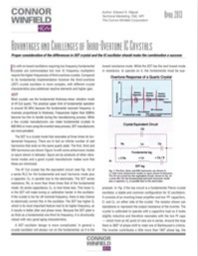Advantages and Challenges of Third-Overtone IC Crystals
ICs with on-board oscillators requiring low frequency fundamental crystals are commonplace but now IC frequency multipliers require the higher frequencies of third overtone crystals. Compared to its fundamental implementation however the third-overtone (3OT) crystal oscillator is more complex, with different crystal characteristics plus additional reactive elements and higher gain.
Download this whitepaper to find out more.
Read More
By submitting this form you agree to [publishpress_authors_data field="display_name" post_id="$ID"] contacting you with marketing-related emails or by telephone. You may unsubscribe at any time. [publishpress_authors_data field="display_name" post_id="$ID"] web sites and communications are subject to their Privacy Notice.
By requesting this resource you agree to our terms of use. All data is protected by our Privacy Notice. If you have any further questions please email dataprotection@techpublishhub.com
Related Categories: Capacitors, Communication, Inductors

